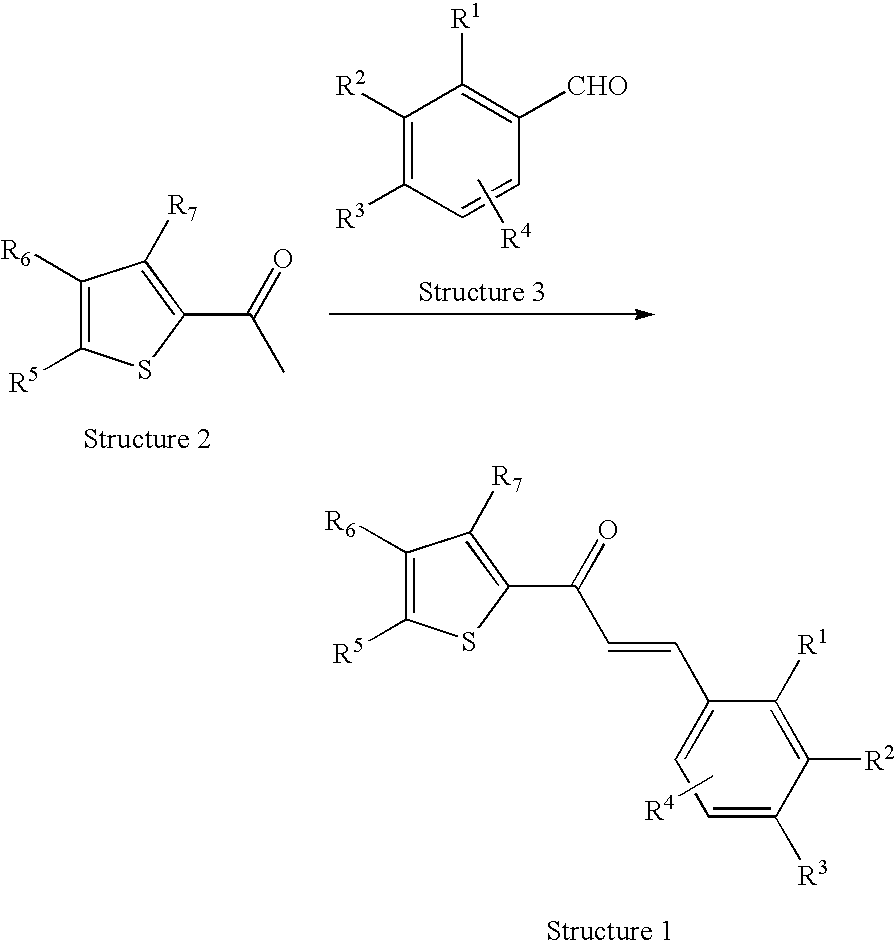Thiophene derivatives
a technology of thiophene and derivatives, which is applied in the direction of biocide, drug composition, immunological disorders, etc., can solve the problems of severe organ, cell, tissue or joint damage, autoimmune response, and unregulated control mechanisms
- Summary
- Abstract
- Description
- Claims
- Application Information
AI Technical Summary
Benefits of technology
Problems solved by technology
Method used
Image
Examples
example 1
[0097]
[0098]a) At 0° C., DMF (4.3 mL) is carefully treated with phosphoroxychloride (2.8 mL) and the mixture is stirred at rt for 20 min before 1,1,1-trifluoro-3-phenyl-propan-2-one (1.55 mL, 10 mmol) is slowly added. The reaction mixture is stirred for 2 h at 45° C. and 18 h at rt, diluted with sat. aq. Na-acetate solution (20 mL) and water (40 mL) and extracted with diethyl ether. The organic phase is separated, washed with sat. aq. NaHCO3-solution, dried over Na2SO4 and evaporated to give 3-chloro-4,4,4-trifluoro-2-phenyl-but-2-enal (2.20 g) as a pale yellow oil.
[0099]b) To a solution of ethyl 2-mercaptoacetate (0.88 g, 6.75 mmol) in THF (45 mL) NaH (271 mg, 6.75 mmol, 60% in mineral oil) is added at −10° C. The mixture is stirred at 0° C. for 30 min before a solution of 3-chloro-4,4,4-trifluoro-2-phenyl-but-2-enal 1.32 g (4.5 mmol) in THF (5 mL) is added. The reaction mixture is stirred at it for 45 min, then treated with 2 N aq. NaOH (2 mL). Stirring is continued for 15 min and...
example 2
[0104]
[0105]A solution of 3-(4-hydroxy-3,5-dimethyl-phenyl)-1-(4-phenyl-5-trifluoromethyl-thiophen-2-yl)-propan-1-one (8 mg, 20 μmol) in 2-propanol (0.7 mL) and 2 N aq. NaOH (0.27 mL) is treated with (S)-3-chloro-propane-1,2-diol (9 mg, 80 μmol) and the mixture is stirred at 65° C. for 24 h. The mixture is cooled to rt, diluted with formic acid (0.25 mL) and separated by prep. HPLC (Waters Xterra MS18 19×50 mm 5 μm, 10 to 95% acetonitrile in water containing 0.5% formic acid) to give 3-[4-((S)-2,3-dihydroxy-propoxy)-3,5-dimethyl-phenyl]-1-(4-phenyl-5-trifluoro-methyl-thiophen-2-yl)-propan-1-one (3 mg) as a colourless lyophilisate; LC-MS: tR=1.06 min, [M+1]+=479.21.
example 3
[0106]
[0107]A solution of 3-(4-hydroxy-3,5-dimethyl-phenyl)-1-(4-phenyl-5-trifluoromethyl-thiophen-2-yl)-propan-1-one (8 mg, 20 μmol) in 2-propanol (0.7 mL) and 2 N aq. NaOH (0.27 mL) is treated with 2-bromoethanol (10 mg, 80 μmol) and the mixture is stirred at 65° C. for 2 h. The mixture is cooled to rt, diluted with formic acid (0.25 mL) and separated by prep. HPLC (Waters Xterra MS18 19×50 mm 5 μm, 10 to 95% acetonitrile in water containing 0.5% formic acid) to give 3-[4-(2-hydroxy-ethoxy)-3,5-dimethyl-phenyl]-1-(4-phenyl-5-trifluoro-methyl-th iophen-2-yl)-propan-1-one (4 mg) as a colourless lyophilisate; LC-MS: tR=1.12 min, [M+1]+=449.15.
PUM
| Property | Measurement | Unit |
|---|---|---|
| temperatures | aaaaa | aaaaa |
| temperatures | aaaaa | aaaaa |
| volume | aaaaa | aaaaa |
Abstract
Description
Claims
Application Information
 Login to View More
Login to View More - R&D
- Intellectual Property
- Life Sciences
- Materials
- Tech Scout
- Unparalleled Data Quality
- Higher Quality Content
- 60% Fewer Hallucinations
Browse by: Latest US Patents, China's latest patents, Technical Efficacy Thesaurus, Application Domain, Technology Topic, Popular Technical Reports.
© 2025 PatSnap. All rights reserved.Legal|Privacy policy|Modern Slavery Act Transparency Statement|Sitemap|About US| Contact US: help@patsnap.com



